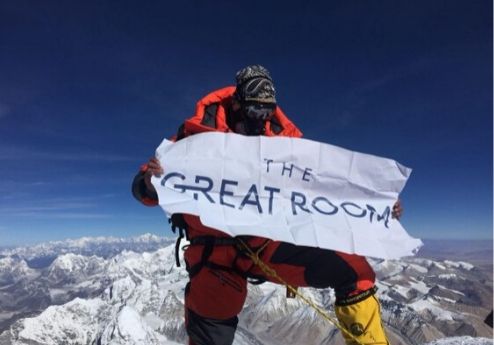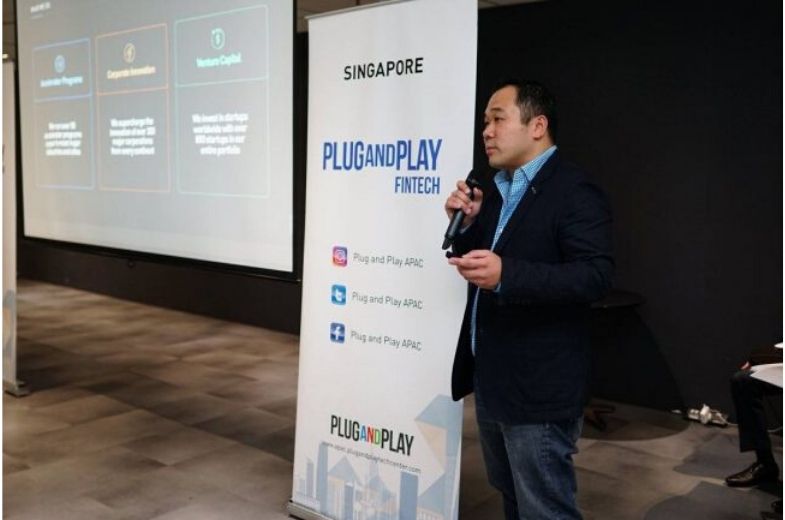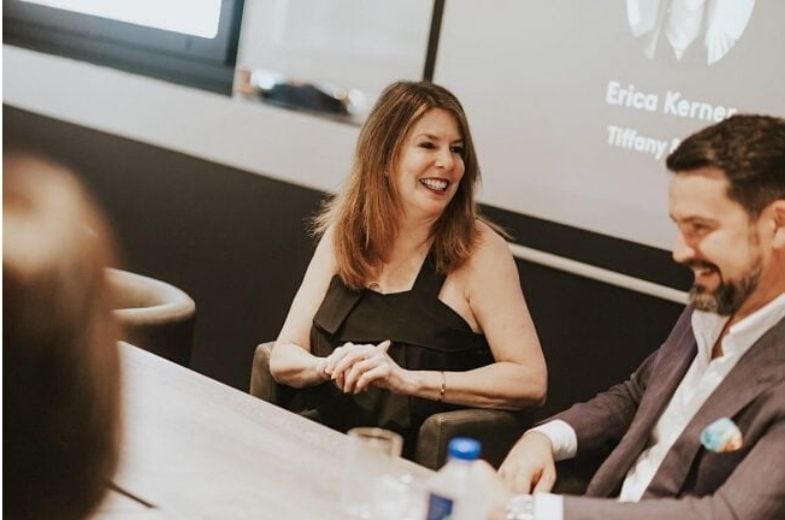As part of The Great Room’s second anniversary celebrations, Erica Kerner, Tiffany’s VP of marketing and communications Asia, gave a fascinating talk exploring how this storied jeweller so successfully stirs desire in the consumer. These are some of the most thought-provoking remarks Erica made during a half-hour discussion with moderator Christian Barker.
Christian Barker: Today’s topic is creating consumer lust, so it seems apt to begin by asking, how is wooing a customer similar to the art of seduction?
Erica Kerner: A basic fundamental of marketing is, you’ve got to create a relationship and a rapport with your customer and if you can’t do that, you’re not going to bring them into the brand, you’re not going to bring them into your product. So if you can create a romance, create those feelings, those emotions that are like what you feel in a romance, you’re going to build a very long-lasting and passionate relationship with your customer. I’ve been very lucky, because working for brands like Tiffany, Nike and Adidas, you have that passionate relationship with your customers. People are very passionate about each of those brands. At each company, I’d often meet people who’d say that I have their dream job — these brands really pursued a passionate connection with customers, which I feel very lucky about. But it’s also a big challenge as a marketer to keep that relationship going.
Christian Barker: Tiffany’s recent campaigns have been very forward-thinking in championing love in all its forms, regardless of gender, sexual orientation or the type of relationship. Can you tell us a little about that new direction?
Erica Kerner: Well, Tiffany, as you know, created the modern engagement ring — the Tiffany setting, the six-prong ring was created by our founder 140 years ago, when he lifted the diamond ring out of the setting so that it captured more light. So being part of love and people’s joyful moments has always been central to our brand. But I think that as consumers and consumer attitudes are changing, we have to change and evolve with that as well. Today, we always talk about modern love — and that love might be between a man and a woman. Or it might be between two men, it might be between two women, it might be the love of a mother and a child, you know? It’s not just romantic love that we talk about in our campaigns. That’s something I’m very proud of. We’ve done campaigns with same-sex couples and that’s a bold move for a mainstream brand to take. It doesn’t make everybody happy, but I’m very proud that I work for a company that’s not afraid to talk about love in all its modern contexts or whomever you are.
Christian Barker: Are there challenges in running a campagn of this nature in a region like Southeast Asia, where attitudes can be quite conservative? So-called ‘alternative lifestyles’ remain illegal here in Singapore, for instance.
Erica Kerner: It’s an interesting, interesting question. I mean we did a campaign about a year and a half ago where we first had the same-sex couple in the film and we had different edits of that film for around the world, because Singapore is not the only place that couldn’t run it. We didn’t run it in the Middle East either and certain other countries. I ran it in Australia but didn’t run it here (in Singapore). There were some pictures of a couple with a child as the bride’s flower girl, which I couldn’t run in Korea because that was too progressive for that market. So yes, you have to know the cultural sensitivities, but the thing that surprised me is, though we didn’t run the ad here in Singapore, the day the campaign broke, the social media love that came in from Singapore for that campaign was fantastic. There were so many people who then said, we’re so proud of Tiffany for showing this, for taking the stand. People were recreating the film and doing their own versions of it, and so even though we never ran that version here, it still got a great response and exposure.
Christian Barker: How do you promote the romance that is so core to Tiffany’s DNA, without alienating men, who can be a little less enthusiastic about all that flowery stuff?
Erica Kerner: Well, before I actually answer the question, I will correct you a little bit about men not being romantic. I have to tell you, one of the things that amazes me the most is when, so many times when men find out I work from Tiffany, they all want to tell me their story of how they went to the store to buy a ring, or how they proposed, and they often get mushier than women when they hear I work for Tiffany. The other thing is, back in the old days, I used to work for de Beers, the mining company, and we used to do a lot of research in China and I remember we were doing a study on engagement rings with men, and sitting in the room behind the one-way glass listening to all these men as they were being shown advertising concepts. They kept saying, “Oh no, don’t use that concept — I want to use that to propose!” Men can be very romantic. The thing we need to be conscious of is that men tend to be motivated differently than women around the engagement moment. We had a campaign about two years ago where we had two phases: the ‘Will You?’ phase and the ‘I Will’ phase. The ‘Will You?’ phase was pure romance and it was really aimed at the woman. It was advertised in women’s channels and it was really all about that romantic moment of the engagement. But then, the ‘I Will’ phase was more targeted to men and that was more about the value creation of the diamond and the craftsmanship. When they make the purchase, men want to know what they’re getting, that they’re paying the right amount for what they’re getting, that it’s going to hold its value, that it’s a good investment, and things like ethical sourcing and supply chain. And so it was much more of a rational message to men and men’s channels.
Christian Barker: Being a brand with a great deal of heritage, obviously you don’t want that sense of history to be lost, but you also need to stay contemporary and relevant. How do you do that?
Erica Kerner: That’s a great question. Yes, we’re 181 years old. And the beauty of the Tiffany brand is that, no matter where in the world you’re from, the power of that blue box is the same in each and every country. I like to say that we make women’s heart beat faster all around the world when they see that blue box. But staying relevant is incredibly important. And our biggest challenge, I think, as marketers, we have a campaign that just launched, and that would answer part of your question — it is very young and very edgy and not something that you would necessarily expect to see from Tiffany. It’s very much talking to a younger millennial customer. It’s got Maddie Ziegler who is 18, and she has around 30 million followers on instagram. More than the Kardashians. Elle Fanning is also in that campaign, on Insta she has around 3 million followers or something. It’s definitely appealing to a younger audience with a product that has a substantial price point — some of the items in that spot are $50,000 products. So you’ve got a really nice juxtaposition, I think, that talks about Tiffany as a brand that you can wear every day as a luxury customer, or as a young millennial. It’s hopefully speaking to both segments, it’s getting a customer to come in and try a $300 ‘Return To Tiffany’ bracelet and say that’s what I want for my sweet 16th birthday, or to also think about something more significant later in life.
Christian Barker: Speaking of social media, Tiffany is very active in that area, correct?
Erica Kerner: I’m not going to talk about statistics, but a major part of our marketing budgets are in social media these days and that’s all about liking and sharing, and having a dialogue with customers rather than just a one-way conversation. A lot of marketing today is around user generated content. So a great deal of the storytelling we do, we’re not telling the story. We may start the story, but then it’s consumers who are picking it up and people want to tell their story. We have a campaign now for our ‘Love & Engagement’ category and it’s real couples telling their stories. We put them in front of the camera, we curated the couples of course, but they’re telling their stories, we’re not telling it for them. Again, we’re very lucky because it’s a category that people want to talk about, everybody has a story to tell. I think that’s how we keep it authentic, because we’re not telling you (the consumer) something — we’re starting a dialogue, which you’re then finishing.
Christian Barker: Our topic today is consumer lust. Lust is a highly irrational emotion. But clearly, making a substantial purchase, there needs to be some sense of rationality, right?
Erica Kerner: No, not necessarily. It can be purely based on feeling. There are other brands in the market, which I’m not going to mention by name, that talk about their products as investments or the financial side of it, but that’s not how we choose to market our products. However, there are clearly some places that jewellery has its benefits — it escapes inheritance taxes, and jewellery is a mobile purchase. There are a lot of reasons why people buy very, very expensive jewelry. That’s not where we tend to to to market our products, and I don’t think people buy jewellery, for the most part, for a rational reason. You buy it because you feel that it makes you feel beautiful or he buys it for you because he thinks you’ll be beautiful in it. I started first with the personal, because the woman’s self-purchase segment of our business has really grown and continues to grow. Women don’t need him to buy that piece of jewellery for her anymore. She loves it when he does, for sure, but does it need to be that way? I think that you buy jewellery or luxury as a reward to yourself or an investment in yourself or similar personal motivations. It’s not really the rational. Though you can rationalise it. You can think to yourself that you’re going to wear this ring every single day and if you wear it for three years, it’s going to cost you $3 a day. So you can find ways to rationalise it, but shopping isn’t about needing — shopping’s about wanting.















